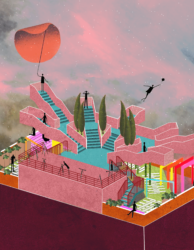
Emotional Food Design
I recently found out that designing for me is much more than just producing beautiful or useful furniture or clothes.
I understood that emotions have a crucial role in today’s society and can be required as a human need for understanding the usability of a product in a lot of different fields. According to Donald A Norman and his book “Emotional design: Why We Love (and hate) Everyday Things”, it has been proven that humans are much more keen on understanding and using a certain product that gives him or her an added emotional value as well as performing its basic task. In other words, people from a post-modern era of consumption look for experiences and are willing to spend their money in new interaction activities between user and products. Can be this applied to food? Is there a new generation of people that look for new emotions and memorable experiences while eating?
Yes, there is, and it has been interesting to analyse how the gastronomy field deals with this existing hedonic culture. This phenomena or culture is condensed into two words named by Pine and Gilmore as Experience Economy, which values in major grade a business that offers memorable events to their clients. Experience Economy was born in the business field but has been applied to architecture, design and many other fields such as Food Design. Seems like we are now able to design eatable products. So, do we cook or design food?
“Lights Meets Chocolate” by Jordi Canudas (Barcelona)
What happened when food is presented to us in a unique format? It is the case of “Light meets Chocolate” an ephermal installation made up with chocolate and lights where the main focus is the user. Jordi Canudas invites us to enjoy eating this precious and eatable material, the chocolate. As a design student I find really interesting how a designer get inspired by cooks and get marvellous ideas from ancient materials such as chocolate. Jordi Canudas goes further in imagining himself manipulating this kind of alive materials. He turns his imagination into a real installation where people play using their five senses with this ephermal and alive material which is here now, and gone later. Is it a good feeling? We are eating a piece of Art! Jordi Canudas knows how to play with emotions and gives his work a strong value of emotional design.
After some research I discovered that the thin layer which used to separate food from design, during the Grand and Nouvelle Cuisine, has already vanished with the appearance of Molecular Gastronomy. Cooks started to further develop technology in the kitchen and became a style of cuisine or an art in which chefs explored culinary possibilities by borrowing tools from the lab and ingredients from the food industry. They were open-minded and implemented innovation in their recipes. Sounds like a design project right? The preparation and presentation of the food became much more important when chemists, cooks, sociologists and designers joined with a unique purpose: to enhance the experience of dining. Ferran Adrià was one of the notable pioneers in this discipline starting from the very low, earning money from working in his dad’s small fisher restaurant, but growing exponentially little by little. What did he do?
“The spring’s thawing”, dish by Ferran Adrià (elBulli, Barcelona)
He started making studies about the experience, perceptions and emotions the users had. He did this to be able to design according to their needs and desires. Food in fact was for him a very useful tool for his creations because he could analyse all of the sensory channels of the human being such as the smell, the taste, the touch, the sight and hearing. After all, designers and cooks had more similarities than differences. Both are willing to built a positive experience which remains in the user’s memory but that can only happen if they develop a deep empathy towards users.
A very interesting research from Chiba University, which explored the sensory channels of humans, came up with the significant relationships between shapes, taste and emotions in users while eating. They proof that expectations and resulting emotions involved in food experience change depending on the shape, taste, smell, environment or even sound which accompanies the dish… and this is why I chose the following picture, by a combination of sensory tests the cooks from Alinea Restaurant in Chicago were able to offer a truly classy dessert materialized in a edible helium balloon to their customers. It is actually filled with real helium, has green apple flavour inside it and is said to be even lighter than air. The way they serve it is unexpected and the experience must be unforgettable!
As I have observed and read, the action of eating and the eatable product have changed all over the years trying to answer to the user’s desperate demand of personal and unique experience. In words of the Belgian bio-engineer and food specialists Bernard Lahousse “Before, a client asked for a beer and this one was served, like that, now, when someone asks for a beer he or she is also waiting for something that combines properly with it, a new experience when drinking the same beer.” He focus on how food can be understood as interaction and how important is that all the senses are adressed by the designer-cook, because the taste can be influenced by touch, colour, weight, shape, material, context or sound. For example steel spoons make you feel that the yogurt you are eating is better than the one you ate with a plastic spoon, although it is complete the same yogurt, what changes is the weight and material of the spoon. The same happens with whisky, if we drink it in a heavy glass cup it will taste more premium than if we drink it in a light plastic cup.
I understood that food is not just food anymore and that more than what we can imagine of how we experience food is not just only in the food but around it. It is about the context interacting with food. Molecular cooks are very aware of this and are already offering us experiences which we will never forget. Curiosity keeps growing inside me after this research and I am looking forward to the surprise of experiencing the power of this innovative discipline and find out how a designer like me and a cook merge and create such an unforgettable emotion!
Author: Teresa Baena




